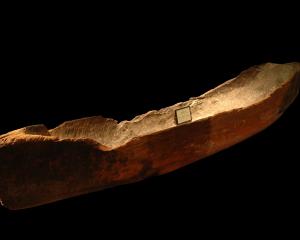The Otago Witness of March 25, 1882, reported: " In consequence of the exposed position Mr Cargill judiciously resolved upon building his house of concrete - a material not yet come into general use, though highly adapted for structures requiring solidity and strength.
"Under the superintendence of Mr Petre, its designer and architect, all that art and science could accomplish was brought to bear in its construction, and a mansion has been completed as firm and solid as if chiseled out of the granite rock - destined, if no vandalism intervene, to stand entire for ages".
Moving inside, the report went on: "The dining-room is tastefully and elegantly furnished, with select paintings adorning its walls. The drawing-room is replete with everything that contributes to convenience and splendour - richly carved ottomans and chairs, walnut sideboards beautifully carved, one of Broadwood's costly pianos, large mirrors, reflecting their elegance ... while the walls are decorated with pictures that could not fail to please the most fastidious connoisseur.
"Nor is the lady's sitting-room less interesting, provided as it is with everything which ministers to comfort and taste. Splendid paintings and drawings, principally of New Zealand scenery - one a beautiful view of the cliffs ... painted by a lady acquaintance; the other a perfect gem of Corregio's, a Madonna holding a child in her left arm.
"The library, well-supplied with books by the most eminent authors, is so constructed that when the company is larger than usual the dividing wall can be readily raised by means of pulleys, and the apartment added to the drawing-room.
"Ascending the spiral staircase, the opening of a glass door leads to the balcony, the floor of which is formed of concrete. From it there is one of the most magnificent prospects that can be seen in any part of the colony.
"Towards the north is obtained a birds'-eye view of Dunedin ... Mount Cargill in the background dotted with houses ascending towards the summit. Then the wooded valley of the Leith interspersed with clearances, Flagstaff forming an interesting background.
"Comprised in the panoramic views also are the hill suburbs of Maori Hill and Mornington with their patches of blue gum and other trees commingled, giving them a rural aspect. And on the flat, in full view, are the townships of Caversham, South Dunedin, Kensington, and St Kilda, irregular in their formation, with the passing tramcars, bearing their living freight to disport on the Ocean Beach, inhaling its invigorating breeze.
"Southward from this, elevated 300 feet [93m] above the level of the sea, the view is not less magnificent ...
"When a southern gale arises the billows come rolling in, and strike with relentless impetuosity against the cliffs beneath the mansion, involving the most terrific diapason in their roar; the sound of the angry waters entering into an adjacent cave contributing to the loud-sounding turmoil."
But "The Cliffs" was not as sturdy as expected. Supposedly fireproof, the building was gutted in 1892, when a fire that had started in the laundry spread through the wooden beams to the main house.
Since the water tank underneath the laundry and the two tanks upstairs could not be reached, little water was available for firefighting and the building and its valuable contents were largely destroyed, although no-one was seriously hurt.
Cargill rebuilt The Cliffs, adding the ballroom at the same time, though financial constraints meant the interior was never quite as splendid as before. E. B. Cargill died in 1903 and the castle was later sold by his daughter, Margaret, and her husband.
It has since been used as a family home, restaurant and cabaret, an evangelical Christian centre and a fine art centre. But in 1974 when permission was refused to turn it into a hotel, the owner of the time began to demolish the building, removing the windows and leaving it exposed to the weather.
Gradually the building was gutted and the woodwork, staircases and anything of value removed.
The ravages of time and weather caused further damage, and in 1996, the ballroom was partly demolished. A demolition order was granted for the rest of the ruins.
The Cargill's Castle Trust was formed at this time, and now owns the ruins of the castle, which has a Category II listing from the Historic Places Trust.












